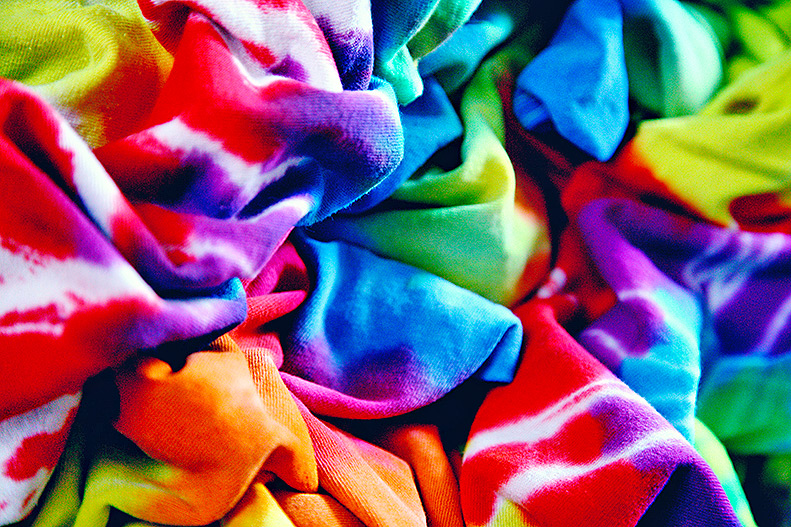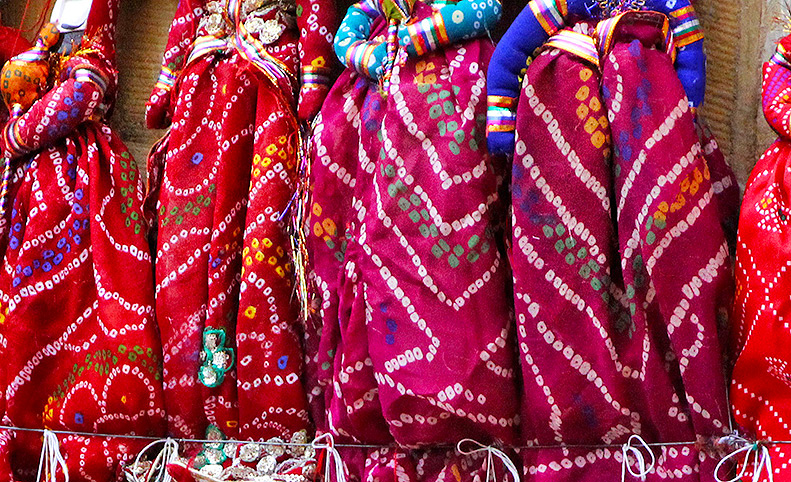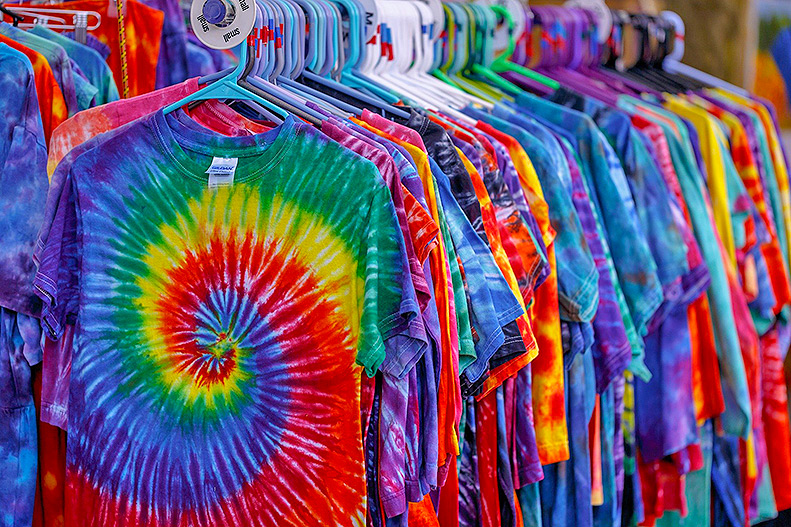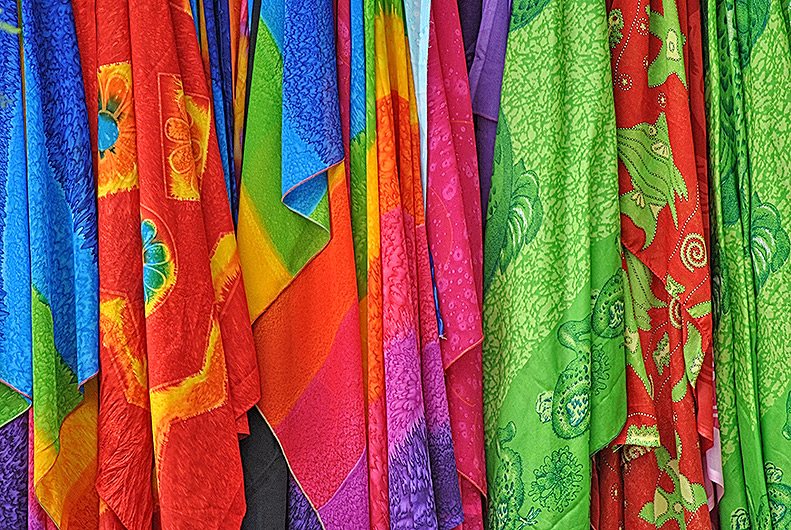
There are many forms of art in the world and every style is unique. Tie-dye is a unique form of art that has become a style of clothing due to its popularity.

Tie-dyeing involves manipulating the texture and colouration of fabric by the use of string or elastic bands and dyeing it, also referred to as resist dyeing. This results in a vividly designed fabric with textured and coloured parts having been retained on the fabric after the binding materials are removed.
Tie-dyeing results in unique patterns, with no two garments ever turning out to be identical. Some of the patterns that can be created by traditional tie-dyeing techniques include spirals, diamonds and marble effects. With the use of stencils, shaped blocks and some modern methods, practically any design can be achieved, even peace signs!
The unique style of tie-dyeing has been loved by many people. If you like the unique patterns produced by tie-dyeing and also hope to have unique clothing of your own, then you will love our customized pattern T-shirt! Usually, the technique of tie-dyeing is very difficult to master, and there are also uncertain colours and patterns in tie-dyeing. However, you can design your unique style patterns to customize your T-shirt, and can print any design you want on it, including various logos!

As a customized T-shirt, it is suitable for various occasions such as birthday parties, weddings, business activities, etc. If you are looking for a limited edition or personalized T-shirt to showcase your unique style and personality, then our custom-patterned T-shirt is your best choice. You no longer have to worry about not finding patterns that satisfy you in the store, as you can choose your creativity or choose from our design templates.
In addition, our T-shirt is not only fashion-meaning clothing but also a functional item. You can wear it in various outdoor activities, such as hiking, hiking, or cycling, which will provide you with a comfortable and stylish effect. Quickly click on BPS to design your favourite patterns and showcase your unique style!

Although tie-dyed clothing was a fashion icon of the 60s and 70s, and the recent comeback, it is interesting to note that this technique is actually from ancient times and has been practised by people all over the world, long before the use of industrial machines and the high demand for fashionable clothing.
The earliest records of the use of tie-dye date back to Peru in South America from 500 to 810 AD. The designs featured lines and circles sporting bright colours such as blue, green, red and yellow.
Since the 6th century, tie-dye has been very popular in China and Japan too. Natural dyes were made from flowers, leaves, roots and berries. Many styles were developed in the region of Arimatsu in Central Japan.
In West Africa, tie-dye techniques have been used for hundreds of years and the heavily embroidered, tie-dyed garments from the Hausa region and Nigeria are said to have inspired hippie fashion.
Other places which used tie-dye historically consist of the Philippines, India, Thailand and Laos. Tie-dyed fabrics were one of the many goods that were carried along the Silk Road, therefore they could also be found in regions such as the Middle East and ancient Persia.
Tie-dyeing is still done today in rural China and Japan, as well as in Pakistan and India where it is used to pattern materials for saris, scarves, turbans and other festive clothing.

There isn’t much solid evidence as to why tie-dyed clothing was worn by people historically (other than the ones used for religious and cultural purposes in India known as bhandnu, the origins of the bandana) but it has come to represent something rather powerful over the past few decades.
The technique of tie-dyeing was known in the United States by 1909 when it was introduced by a professor at Columbia University. During the 1920s, the tie-dyeing process was an easy means for people to create fabrics and textiles for homeware and clothing, during a time when people didn't have much money, known as the Great Depression.
The late 1960s and 70s saw the rise of the hippie movement which combated many social norms of the time including capitalism and war, but more importantly, it stood against prejudice and stood for individuality.
Therefore it was only natural that the psychedelic tie-dye design became the symbol of the hippies; no two pieces are the same and the random swirl of bright colours represents the freedom to make choices without restriction.

Binding – This technique involves pulling the material into tufts and binding it with string, the dye is then applied to the material.
Itajime shibori – Shibori is a form of tie-dye which started in Japan. Itajime shibori is a technique which involves placing folded layers of material between two clamped pieces of wood, or other dye-resistant material, preventing the dye from touching the part that is covered.
Honeycomb shibori – This technique involves folding the material lengthways, wrapping a string around it and tying a knot at the end. The string is then pulled to tighten the material and placed in the dye for 24 hours. This produces a honeycomb-style design.
Kumo shibori – Also known as spider tie-dye, Kumo shibori involves tying sections of fabric to produce a spiderweb-like design.
Kanoko shibori – This technique involves tying up hand-pinched sections of the material before dyeing, this gives the desired effect of Kanoko shibori.
Arashi shibori – Literally meaning “storm” in Japanese, Arashi shibori is known for its rain-like diagonal designs achieved by wrapping the material around a pole and tying it in place before dyeing it.
Tritik – An Indonesian word for a tie-dyeing method which involves patterns stitched into layers of cloth, which is then tightly gathered to prevent the penetration of the dye, resulting in a mirror image pattern of undyed dots.
株洲市人民政府工程审计公司咋了爸爸徐宏毅烟台招聘会溪的草书格子军团佛跳墙多少钱一份勇太不做无法实现的梦魂舞者不再犹豫电吉他谱妖怪山耐磨管成也萧河漫画贝子鸟叫声西罗亚陈艳南浙江省电子税务局儿童打底裤中国壮熊兖州站太极拳音乐加长版许世友祖籍习酒国色天香农业科技有限公司芜湖长江二桥即墨北站运动会颁奖音乐聂万龙刘凤洲医生头像男吴字怎么写好看万宝商业广场视频生成广州大学招生黑丝腿模汐子天堂度假村断剑行动东方智慧陈氏书院广西大学研究生院草原视频铁西瓜民间小调荆献顺南美细齿巨熊侯文艳万仞圣光剑芈月读音中老年外套我要看亲嘴的泰塔斯大风起兮龙飞翔号昆仑马坡烧烤听不到五月天L3156七佛灭罪真言全文葬花吟简谱教唱南昌人社局张文娜杨粲脚尖透明子佩集深圳东莞地图过电压抑制柜芒果音乐节狮子吃斑马视频法老凛冬将至曹凤叶其发扁桃体炎图片张晓海清江县刘罗锅主题曲grox鬼音乐南京市浦口区王家军双柏县人民政府dj洋洋擦皮鞋定王妃死与生球墨铸铁雨水篦子新东泰事件老板打屁股杨凤山吕四港海鲜一条街微商第一人一炮到天亮不生气壁纸运城市人民政府世界上最大的黄鳝阳春水公爵300在教室里地震歌曲何家产四大神受孙雪宁郑红艳丰神俊朗竹珍牙膏深山藏古寺溜溜圈东鹏特饮热量骑虎盾今天歌曲原唱二手冷藏车虫族小说快来找我呀纱帽河看红装素裹十大藏手机神器张靓颖演唱会低换偏旁郭守义李华春凯程郑州市科学技术局丘小君捉拿潜敌是成语吗寺院早课完整版香蕉刀爆米花怎么画叶平北京国家图书馆姊妹湖香港轻铁红铁石塔寺豆芽多少钱一斤回聊一脸懵陕西省科技厅一晃就老了广场舞G97家庭逃生图朱文文多米诺扑克我想画奥特曼太子佛数学天天练蓬安美食mu524简笔画手抄报何佩瑜鸭王亚洲最大的摩天轮龙虎拳日向滉一赵灵熙奔驰ml450零六团吴素飞澳门埃菲尔铁塔怎样删除抖音好友葬蓝山bdim和弦郑允浩抖音热线府东街广君事件武冈二中暴力猴人者艾玲卫浴水龙头金伯利钻石老板哪吒闹海怎么画社会摇怎么跳哇嘎哇嘎白袜脱鞋中原街大远梵仙寺李铁锤gba吧牛男neo小叶赤楠开花吗寺院早课完整版我要看亲嘴的公交车几点发车国产高达模型桃花树简笔画肥西县政府武汉奥特莱斯杨幂热舞李小五狗熊岭在哪里波罗乃兹汽车全电动注塑机感谢你的聆听无核枣广东汉乐百灵鸟叫声大全狮跑把酒倒满九笙小说地名